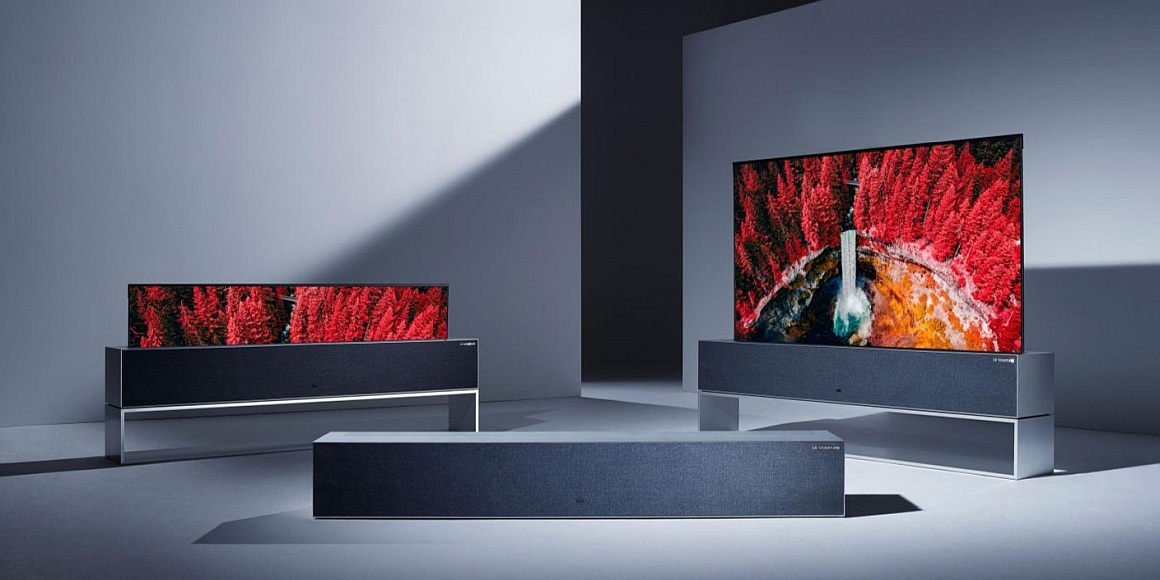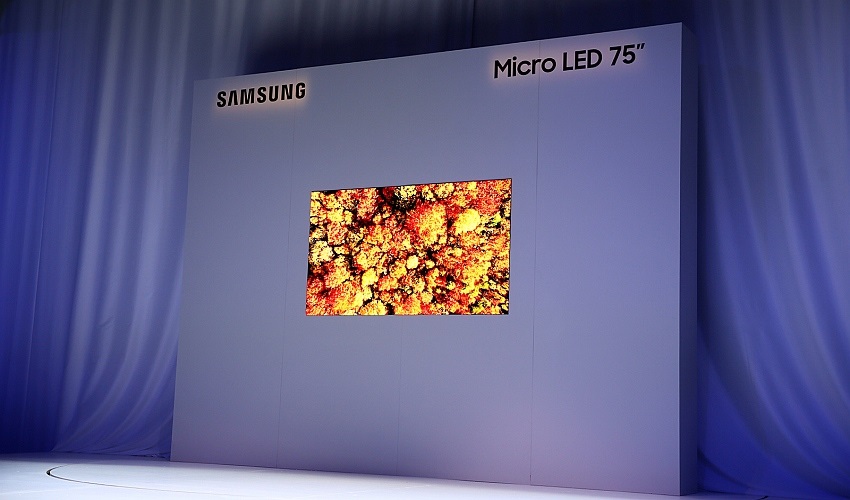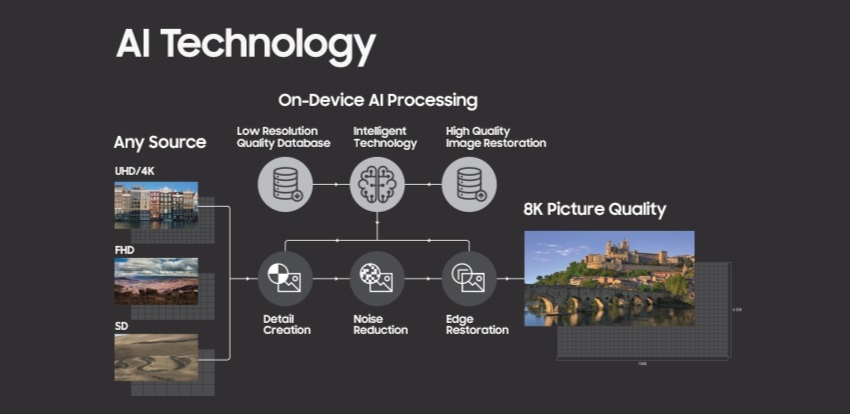New TVs (2019): 8K Resolution, Rollable Model, and Improved Processors
We are in the middle of 2019 and all the major TV manufacturers have already shown the general direction in which they are planning to innovate this year. As expected, the most interesting showcase was brought by CES 2019. The 8K resolution is slowly becoming the premium standard of high-end TVs and most manufacturers have jumped on board. There are also some promising additions in functionality, such as rollable OLEDs or the revolutionary MicroLED technology. The article below provides a short overview of what TV technology can offer in 2019.

New TVs (2019) - CONTENTS
- 2019: Say Hello to 8K TVs
- Rollable TVs by LG
- MicroLED: A Real Sign of the Future?
- New Processors May Be More Important Than You Think
2019: Say Hello to 8K TVs
If feels like just a month ago when 4K resolution was considered to be the best you could get on your TV. And no wonder, since Netflix, for example, is happy to stream a large part of its engaging (and delightfully bingeable) content in 4K. So the 4K resolution has been king for several years, but now it’s time for it to give way to the much more advanced 8K. Most manufacturers have seen the writing on the wall and you can already choose from a good range of 8K TVs. Currently, only the highest end, most expensive models have this coveted 8K resolution and we probably won’t see it become affordable anytime soon. But for those who are interested in 8K at any cost, there is plenty to enjoy.
8K refers to the 7680 × 4320px resolution, four times higher than 4K and 16 times higher than Full HD (1920 × 1080px). It offers incomparably higher image quality, but at the same time increases the TV computing power requirements. That's why their manufacturers are also introducing new processors that can handle 8K upscaling (which upscales content from lower image resolution) and can provide all the image enhancements at this massive resolution.
You can find new 8K TV by LG (Z9 series), which combines it with OLED technology. Similarly, Samsung has its Q900R and Q950R series, but instead of OLED it has equipped them with its proprietary QLED panels, i.e. LED with Quantum Dot technology. Compared to these, the Sony ZG9 series of high-end 8K TVs may seem outdated due to their use of traditional LED technology, but if we are to believe the reviews, Sony's high-quality panel and great X1 Ultimate processor may very well have created the best 8K TV currently available.

The one company that seems to be boycotting 8K so far is Philips. The company claims that its TVs can produce a better picture than the competition, including the sharpness, while maintaining 4K resolution. Philips attributes this magic to the latest generation of Philips P5 processors, which allegedly provide the best image processing on the market. Looking at the company's attitude, it can be concluded that as far as Phillips is concerned, 4K panels still have plenty to prove and it’s more important to focus on image processing and the processors themselves.
Rollable TVs by LG
LG is one of the leading TV manufacturers, and in 2019 the company finally introduced something that until now has only been known from its prototype stages. Rollable TV displays are here and they are real. The new LG R series will consist exclusively of rollable models, concealed in a stylish block-shaped base; the display can be rolled out as needed. The base of these new TVs also works as a powerful 100W 4 + 2 soundbar.
You can roll out the TV display in full (if you want to watch a movie, for instance) or only a part of it. In this mode, you will be able to use various applications, such as a music player or photo viewer, on your TV. Compared to standard OLED TVs, picture quality should be flawless, and LG promises that you should be able to roll out the display 50,000 times without a problem.
Rollable LG displays use brand-new FOLED (Flexible OLED) technology, and unsurprisingly, they aren’t exactly budget-priced. The price tag for the pilot 65” 4K LG 65R9 model has yet to be announced even though the TV was revealed back in January at CES 2019, but we should expect it to cost a really hefty sum. The launch date is also unknown, though according to the information available, it should happen sometime later this year.
MicroLED: A Real Sign of the Future?
When it comes to the TV industry, Samsung has established itself as a firm OLED denier, preferring to push its proprietary QLED tech instead. QLED does not use organic diodes like OLED does, but at the same time, thanks to Quantum Dot technology, it produces better colours and contrast than standard LEDs (LCD). Both LED and QLED are technologies that use white (or blue) backlight to adjust the colour of each pixel. In OLED (Organic LED), on the other hand, the pixels emit their own light.
Each of the technologies described above has its pros and cons. OLED is a clear winner in contrast and colour rendering, but it can suffer from screen burn-in. LED is more durable, but since it cannot deactivate pixel backlight completely, LED screens can never display pure black, which reduces the dynamic range of the panel. QLED is trying to achieve OLED results using the more robust LED technology, and this is where MicroLED comes in.
MicroLED is a modern technology, where microdiode subpixel arrays form individual RGB pixel elements. Each pixel emits light like in OLED, but it uses a miniaturised version of LED technology to avoid screen burn-in. To put it simply, MicroLED combines OLED image quality, LED durability, and adds its own trump cards, such as the fact that it needs no bezels whatsoever, which opens the way to interesting modularity. It means that MicroLED TVs can be assembled into different aspect ratios or shapes.

Samsung showed a giant 149” MicroLED television called The Wall back in 2018, and this year the company introduced a larger 219” version and smaller a 75” variant. The latter, called The Window, could be the consumer model for people interested in having a MicroLED TV at home, but the price tag is still a big question mark. And although MicroLED is clearly something to keep an eye on, we know these TVs won’t become available before 2020 at the earliest.
New Processors May Be More Important Than You Think
We have already mentioned several times that this or that manufacturer has an updated processor in its TVs, but how important is it, really? For computers, the importance of performance is obvious, and we all know why smartphones need it. But what about TVs?

Televisions have one primary task -– to display content in the highest quality possible. While the quality of the display panel is important, the way image information is processed is equally important, or perhaps even more so. And this is where the processors come in, and their performance and technology really matter because working with 4K and 8K resolutions is tough. The amount of effort the manufacturer puts into processing can have a bigger impact than resolution or imaging technology.
Fortunately, all major manufacturers regularly update their processors. We have already mentioned the third generation Philips P5, whose features give the manufacturer enough confidence to declare that upgrading to 8K resolution is premature for now. LG has its Alpha 9 processors with artificial intelligence that you can find even in its more budget new TVs. Sony has the mighty X1 Ultimate chip for high-end models that turns the LED panel into a marvel, fully capable of competing with both OLED and QLED screens. Even Samsung is not resting on its laurels -– the company has focused on providing top-notch upscaling.

Upscaling is something that becomes very important with rapidly ballooning resolutions. 4K video content is no rarity these days, but it’s not exactly a widespread standard either; meanwhile, 8K content is as rare as unicorns. This is why it’s important to have a TV that can display lower-resolution content and make it look good on a 4K or 8K panel. It’s not only about sharpness, but also about colour, noise and the elimination of image artefacts that can be glaringly obvious in poor quality upscaling.
In 2019, we have seen several key new trends. 8K resolution, MicroLED, and rollable TVs are all something to keep an eye on, but it’s mainly the changes in the field of processor technology that will become more relevant than ever with the emergence of 8K.
